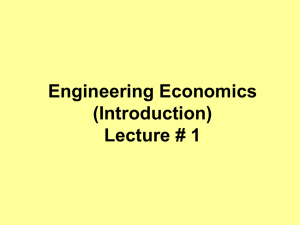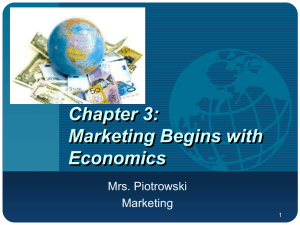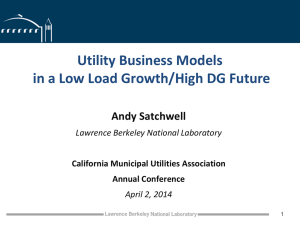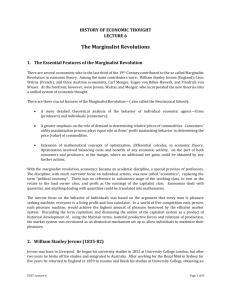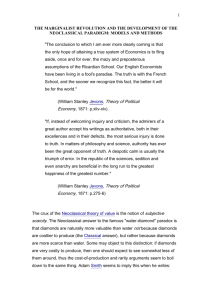William Stanley Jevons
advertisement
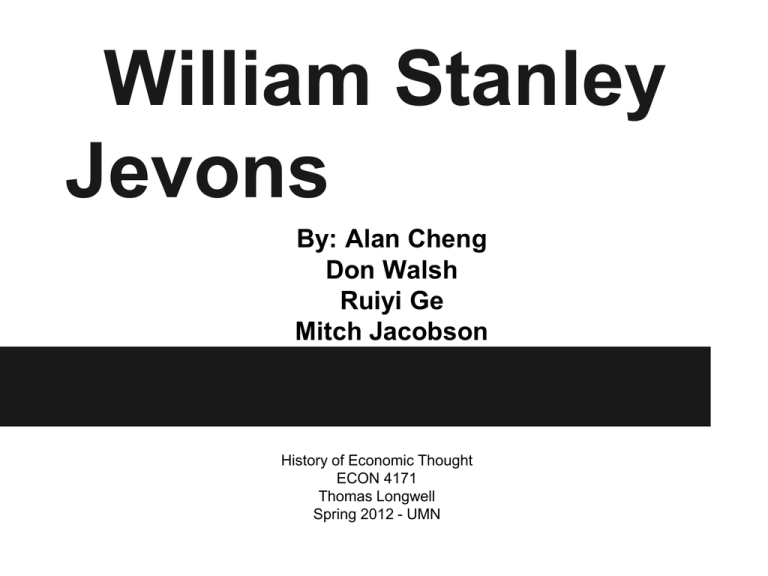
William Stanley Jevons By: Alan Cheng Don Walsh Ruiyi Ge Mitch Jacobson History of Economic Thought ECON 4171 Thomas Longwell Spring 2012 - UMN Biography Born September 1st, 1835 in Liverpool UK. • • • 1850 – At age 15, attended University College School in London for 2 years o Studied chemistry and botany 1853 - Accepted an assayership for the new mint in Australia 1859 - Returned to University College School, this time focusing on the moral sciences, receiving a B.A. and M.A. Biography Continued • • • • 1866 - Became a tutor at Owens College in Manchester. o Became professor of logic and mental and moral philosophy. o Cobden professor of political economy at Owens College 1867 - Married Harriet Ann Taylor 1880 - Resigned from job - bad health, depression, and pressure of literary work. 1882 - Drowned while bathing near Hastings, UK Hobbies were traveling and music Books he authored 1863 - A Serious Fall in the Value of Gold 1865 - The Coal Question 1869 - The Substitution of Similars, The True Principle of Reasoning 1870 - Elementary Lessons on Logic 1871 - The Theory of Political Economy 1874 - Principles of Science 1875 - Money and the Mechanism of Exchange Theory of Political Economy Introduction “In economics. . . we must reason mathematically” • • • • • • Economics is a mathematical discipline not out of convenience, but rather because economics fundamentally deals in quantities Describes the usefulness of theory in the absence of precise data Many quantities (utility, pleasure, pain) cannot be expressed in units, nor need they be Practically, the laws of economics differ only in magnitude between man and nation Economics could very well be an exact discipline, were it not for the difficulty in gathering data In the broadest sense, all human action is guided by pleasure or pain Chapter 2 - Theory of Pleasure and Pain • • • • • • Value of pleasure and pain determined by four circumstances: o Intensity o Duration o Propinquity/Remoteness o Certainty/Uncertainty Quantity of pain or pleasure is measured as sum of intensity over time. Pain is the opposite of pleasure (one is negative and one is positive respectively). Algebraic sum of pain and pleasure with the goal to maximize pleasure. The intensity of anticipating a feeling is a function of the future actual feeling and of time which increases as the moment of realization is approached. The intensity of anticipation is affected by the certainty/uncertainty of actual occurrence. Y-Axis: Intensity of pleasure/pain X-Axis: Time Chapter 3 - Theory of Utility • • • • • • • • Utility defined: The abstract quality whereby an object serves our purposes, and becomes entitled to rank as a commodity. Anything that can produce pleasure or prevent pain may possess utility. Utility is not an inherent quality, but a circumstance arising from relation of man's requirements. Utility decreases as the quantity of a commodity increases. Differential of total utility curve is "degree of utility" The "final degree of utility" is the degree of utility of the last addition. Dimensions of Utility: MUT/T Actual, Prospective and Potential Utility X Axis: Quantity of a Commodity Y Axis: Utility Possessed Chapter 4 - Theory of Exchange • • Ambiguity of the term Value o "Ratio of Exchange" Numerically expresses the ratio or exchange rate of commodity A vs commodity B "The Ratio of exchange of any two commodities will be the reciprocal of the ratio of the final degrees of utility of the commodity available for consumption after the exchange is completed," In bottom equation, right side is the commodity he is buying and left side is what he compares it to in his possession, like pennies. The consumer consumes X quantity on right side until it is equal to the left side Chapter 5 - Theory of Labor • • • • Definition of Labor - any painful exertion of mind or body undergone partly or wholly with a view of future good. Three Quantities Involved: o Amount of painful exertion o Amount of produce o Amount of utility gained "As long as he gains, he labors, and when ceases to gain, he ceases to labor" The richer a man becomes, the less does he devote himself to business -- will have little problem hiring someone to lose some profits in exchange for more pleasure or less pain. Y-axis - Pleasure/pain X-axis - Time Curve ABCD - Pleasure/pain Curve PQ - Utility Point M is where the pleasure gained is equal to the pain caused by working Chapter 6 - Theory of Rent • • • • • First discovered by James Anderson. Different pieces of land are different in fertility, and yields different amount of produce to the same labor. Application of capital = Application of labor. The produce will not increase proportionally to the amount of additional labor applied to the land. The final rate of production ultimately sinks towards zero. Chapter 7 - Theory of Capital • • • • • • • Economics = Science of Capitalisation. Fundamentally agrees with Ricardo. Capital consists of wealth employed to facilitate production, or to support human beings. Investment of Capital = (Greatest Amount of Capital) x 0.5(Investment Time). Circulating Capital & Fixed Capital. Free Capital. Wages of labor. Stock of food, clothing, etc. are a main part of capital. Conclusion • • • • This model’s next step is regarding population as variable “What is truth?” The “noxious” influence of authority Produce = profit + wages Jevons Paradox • • • Postulated by Jevons in 1865 James Watt's coalfired steam engine raised concerns about coal reserves Jevons argued the opposite is true • Experts promised the increased efficiency would reduce coal consumption Marginalism "External goods have a limit, like any other instrument, and all things useful are of such a nature that where there is too much of them they must either do harm, or at any rate be of no use." • Diminishing returns • Marginal Revolution Marginal Revolution • • • • • Jevons, 1871, "Value depends entirely on utility" Menger, 1871, Law of diminishing marginal utility Walras, 1874, Mathematical treatment Considered the 1st generation of the revolution Further generations took the idea of marginalism and applied it to concepts other than utility Carl Menger • • • • • Carl Menger (Austria) Feb 28, 1840 - Feb 26 1921 Founder of Austrian School of Economics. 1871 Published Principles of Economics. Theory of value based on marginal utility. Prices determined at the margin. Leon Walras • • • • • • • Leon Walras (Switzerland) Dec 16, 1834 Jan 5, 1910. Son of French economist Auguste Walras. Studied engineering. Tried careers as a bank manager, journalist, romantic novelist and a clerk at a railway company before turning to economics. Professor of Political Economy at the University of Lausanne, Switzerland. Influenced by his father. Called for nationalization of land. Found the value of goods by setting their scarcity relative to human wants. William Jevons, Renaissance Man • Related business cycles to sunspots • Jevons’ method of inverse probability • Logic and the logic piano • Jevons’ Number: 8,616,460,799 Citations http://www.econlib.org/library/Enc/bios/Jevons.html http://mises.org/page/1459/Biography-of-Carl-Menger-The-Founder-of-theAustrian-School-18401921 http://socserv2.socsci.mcmaster.ca/~econ/ugcm/3ll3/jevons/mathem.txt http://www.bun.kyoto-u.ac.jp/~suchii/holmes_7.html http://mathworld.wolfram.com/JevonsNumber.html http://plato.stanford.edu/entries/william-jevons/ http://www-history.mcs.st-andrews.ac.uk/Biographies/Jevons.html



